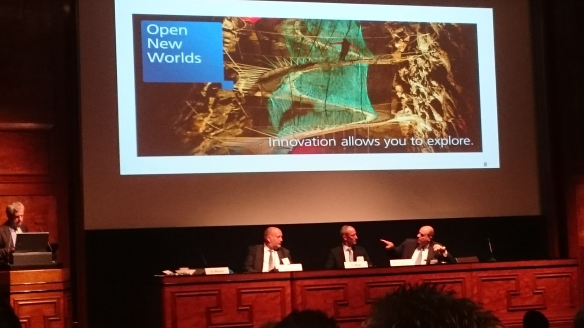It’s exciting times for the publishing market. It is clear to me, from the Interquest Digital Book Forum held on Tuesday 28th in London that, when we look at the publishing market we see it is poised at the beginning of a new world of opportunities.

Benoit Chatelard (right) discusses Ricoh’s Vision of the Future at Interquest
Over the last five years we have seen that digital book printing has become mainstream.
Publishers have been taking advantage of the digital printing to go beyond simple print on demand. They are using sophisticated virtual stock strategies and ASR (Automated Stock Replenishment) not only to reduce their inventories (and therefore their risk) but also to revive their backlist catalogues. So it’s no surprise that, according to Interquest, 89% of print volumes in Europe are now short runs.
In fact according to one publisher at the event, “Print on demand is the hidden saviour of the small publisher.”
Print on demand is the hidden saviour of the small publisher
High quality colour – the next breakthrough
We are finding that publishers are now looking to use the benefits of digital printing for as much of their catalogue as possible. This means that they want higher quality for colour books – especially Scientific Journals, Children’s books and trade books. However they also want the costs as close to offset printing as possible – i.e. Inkjet costs.
This requires a level of print quality significantly better than the majority of inkjet systems installed in the marketplace.
That’s why Ricoh’s ProVC60000 colour inkjet platform has been capturing publishers’ attention. It offers superb quality colour inkjet which now make it possible to print high quality books and journals, even on offset coated stocks. Elsevier’s Johan Van Slooten states the detail and the sharpness of the inkjet samples were better, adding: “Digital printing can result in better quality than litho.”
Digital printing can result in better quality than litho.
Amazon-like service, worldwide
Publishers see how Amazon.com has effectively set customer expectations with fast turnaround, 24 hour delivery and rapid response.
And this is what publishers are increasingly looking for.
The larger publishers really want to achieve this worldwide – that’s why there was so much interest in local printing and in particular the distribute and print model.
A brave new world for book manufacturers
All in all we think this represents a significant challenge for book manufacturers. It’s no longer just about substituting offset with digital, but it’s really about how to re-invent production to take advantage of new industry 4.0 technologies and processes.
Every book printer we talk to confirms that, in this new world of short SLAs, shortening print runs and flexible business models, then automation is essential if they are to continue to be profitable.
That’s why we have launched our new Digital Book Printing Solution. Built on Open Standards such as XML, PDF and JDF, it works with many digital print technologies. It is designed to help book manufacturers produce short run books profitably and cost-effectively. Using Ricoh’s longstanding heritage in financial markets the solution can batch print jobs to make printing more efficient and track and trace work so book printers and publishers alike know exactly where each job is.
Our rapidly growing presence in the European book printing marketplace is supported by our headline grabbing technologies. They include superb quality colour inkjet which now makes it possible to print high quality books and journals -even on offset coated stocks. Our high performance heavyweight digital toner solution is not only ideal for book covers but also for ultra-short run books.
Print production capabilities, combined with quality and seamless job delivery, enable PSPs to redefine their business approach to more effectively address a broader range of markets.
A model approach

Benoit Chatelard Vice President, Production Printing Group, EMEA
Who said print was in decline? According to Interquest US commercial print volumes have been increasing every year for the past five years.
In our view there is a new mood of optimism in the publishing market. Digital print technologies have enabled publishers to reduce their risks and takes out wastage .
Now it’s time for the next phase. To explore new business models – and open new worlds in publishing.








